Japanese beetles may be small, but they can wreak havoc on your lawn and garden if left unchecked. These shiny, copper-colored pests are a gardener’s nightmare, capable of devouring leaves, flowers, and even grass roots in no time. If not controlled, they can quickly strip plants of their foliage, weakening them and making them more vulnerable to disease.
The good news? You don’t have to let these destructive insects take over your outdoor space. With the right strategies, you can control Japanese beetles in your lawn and garden effectively while maintaining a healthy and thriving landscape.
This guide will walk you through everything you need to know about identifying, managing, and preventing Japanese beetle infestations using natural, organic, and sustainable methods. From handpicking and traps to introducing beneficial insects and selecting beetle-resistant plants, you’ll discover the best ways to protect your yard from these invasive pests. Let’s get started!
What Are Japanese Beetles?
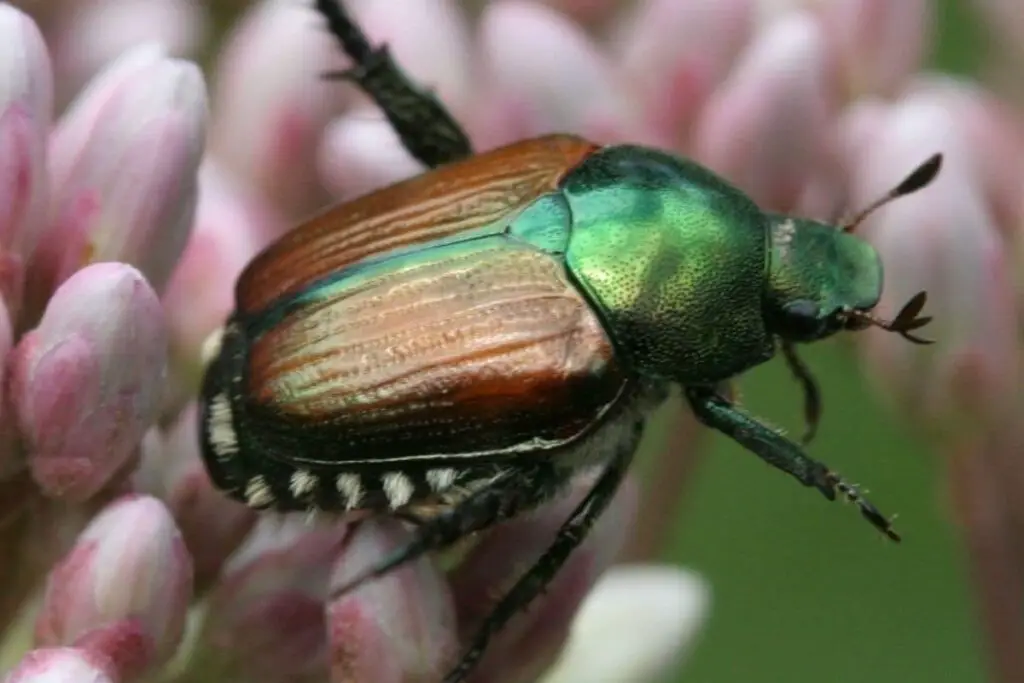
Japanese beetles (Popillia japonica) are invasive pests native to Japan that have become a widespread problem in the United States. First discovered in the early 1900s, these shiny, metallic-green beetles with copper-colored wings have since spread across most of the country, causing significant damage to lawns, gardens, and agricultural crops.
What makes Japanese beetles particularly destructive is their two-stage attack on plants. As adults, they feed on the leaves, flowers, and fruit of over 300 plant species, skeletonizing foliage and leaving behind a lacy, damaged appearance.
Meanwhile, their larvae—commonly known as grubs—live underground, feeding on grass roots and causing brown, patchy lawns that can be difficult to restore. Because they target plants both above and below the soil, Japanese beetles can quickly overrun an area if left unmanaged.
Fortunately, there are effective ways to control Japanese beetles in your lawn and garden using a combination of natural, organic, and preventive methods. In the next sections, we’ll explore how to identify, manage, and prevent these pests to keep your outdoor space thriving.
Why Are Japanese Beetles a Problem?
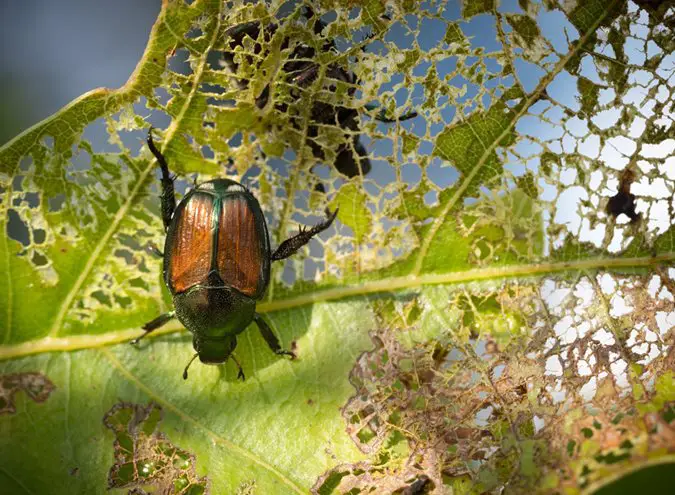
Japanese beetles are a serious threat to gardens and lawns due to their incredibly broad diet, feeding on over 300 plant species, including roses, grapes, raspberries, linden trees, and more. Their feeding habits leave behind skeletonized leaves, chewed flowers, and damaged fruit, making plants unsightly and unhealthy.
If you’ve noticed brown patches in your lawn or plants with leaves that appear lacy and devoured, Japanese beetles may be to blame. Their dual-stage damage—with adults feeding on plants above ground and larvae (grubs) attacking grass roots below—makes them a persistent and destructive pest.
Left unmanaged, these pests can:
- Destroy the appearance of your plants and lawn, reducing curb appeal
- Weaken plants, making them more vulnerable to disease and further pest infestations
- Ruin vegetable and fruit harvests, significantly affecting home gardens and crops
- Cause extensive lawn damage, as grubs feed on roots, leading to dead patches that can attract other pests like moles and birds
Because of their rapid spread and high reproductive rates, these beetles can quickly take over an outdoor space. That’s why it’s essential to control Japanese beetles in your lawn and garden before they cause irreversible damage. In the next sections, we’ll explore the most effective ways to manage and prevent these invasive pests.
Step 1: Identify the Problem
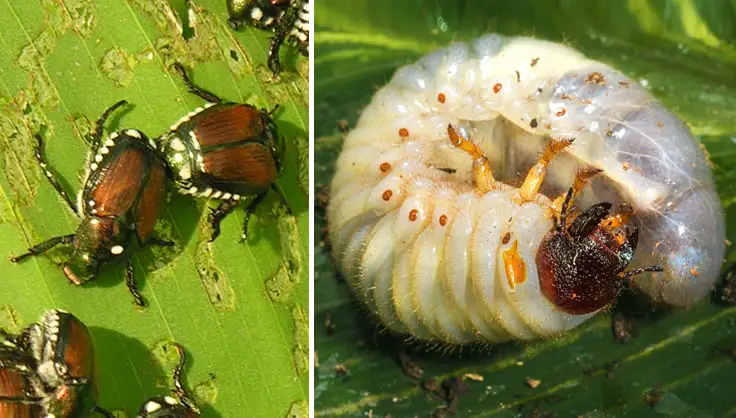
Before jumping into solutions, it’s crucial to confirm that Japanese beetles are the real culprits. Misidentifying the pest could lead to ineffective treatments and further damage to your lawn and garden. To control Japanese beetles in your lawn and garden effectively, you need to recognize them at both their adult and larval stages.
Adult Japanese Beetles:
- Appearance: Shiny, metallic green body with copper-colored wings and distinctive white tufts of hair along their sides.
- Behavior: Highly active during the day, especially in warm, sunny weather. They often cluster in large groups on plants, feeding on leaves, flowers, and fruit.
Japanese Beetle Larvae (Grubs):
- Appearance: Creamy white, C-shaped grubs with soft bodies and six small legs near their heads.
- Behavior: Found in the soil, feeding on grass and plant roots. They cause brown, dead patches in lawns, making turf easy to pull up like loose carpet.
You’re more likely to spot adult beetles from late spring through summer, as they emerge to feed and lay eggs. The grubs, however, are most active underground in early spring and fall, when they feed on roots before maturing into adult beetles.
By correctly identifying Japanese beetles in all stages of their life cycle, you can take targeted action to prevent their spread and minimize damage. In the next steps, we’ll explore effective strategies to eliminate these pests and protect your lawn and garden.
Step 2: Remove Japanese Beetles by Hand
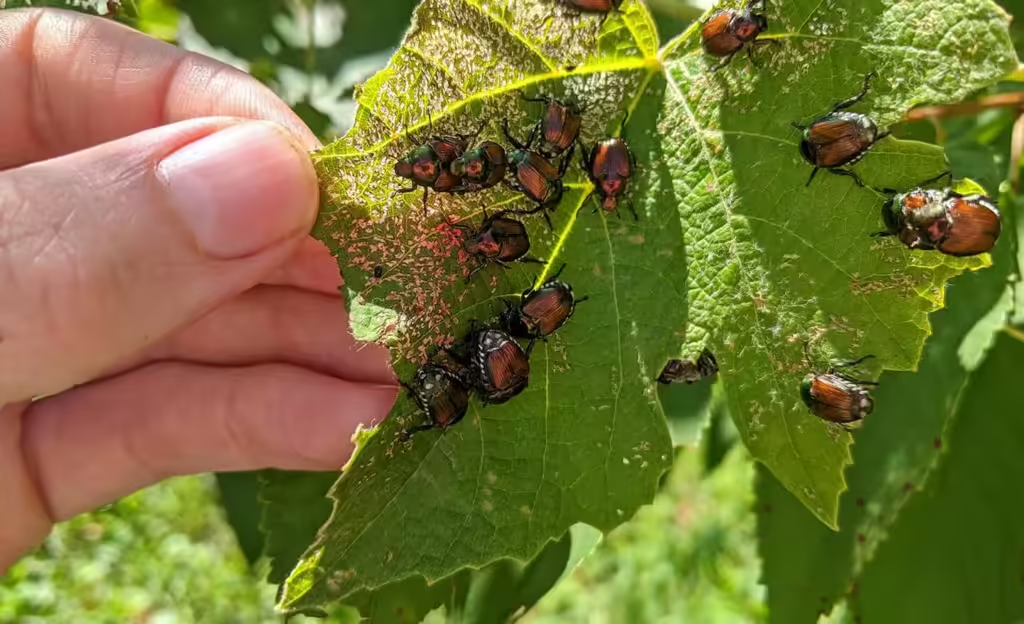
Handpicking Japanese beetles is one of the most effective, eco-friendly, and chemical-free methods for controlling small infestations. While this approach requires patience, it can significantly reduce beetle populations and prevent them from spreading.
How to Do It:
- Inspect your plants early in the morning – This is when beetles are sluggish and easier to remove. Check leaves, flowers, and stems for clustered beetles.
- Use a bucket filled with soapy water – A mixture of water and dish soap will quickly kill the beetles upon contact.
- Gently knock or shake beetles into the bucket – You can also pluck them off by hand if needed.
- Repeat daily – Regular removal prevents them from laying eggs in the soil and reduces future infestations.
This method is labor-intensive but highly effective, especially for small to moderate infestations. For larger outbreaks, handpicking should be combined with other control methods to fully control Japanese beetles in your lawn and garden.
Next, we’ll explore additional techniques to help manage these pests more efficiently.
Related Topics:
Step 3: Use Natural Traps
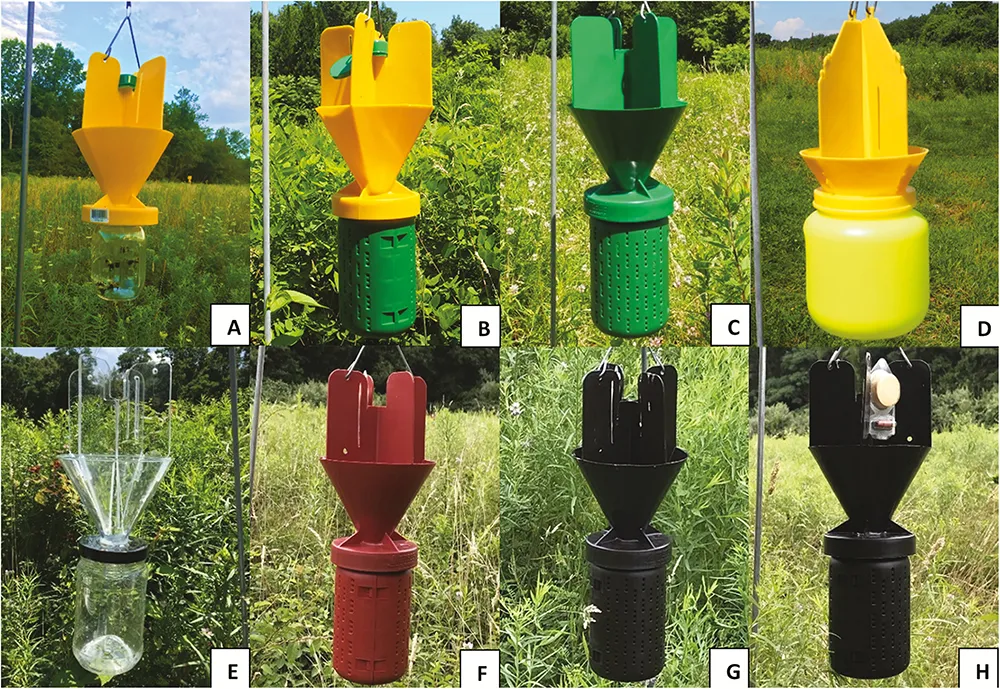
Using natural traps is a safe and effective way to manage Japanese beetles without worsening the problem. While store-bought traps may seem like an easy solution, they can attract more beetles than they catch, leading to a larger infestation in your yard.
Avoid Store-Bought Traps:
Many commercial Japanese beetle traps use floral or pheromone lures, which can draw beetles from surrounding areas into your garden. While they do catch some beetles, they often increase the overall number of pests rather than reducing them.
DIY Trap Solution: Use “Trap Crops”
Instead of using artificial lures, plant strategic “trap crops”—plants that Japanese beetles love—to keep them away from your most valuable plants.
- Best Trap Crops: Marigolds, geraniums, zinnias, and roses
- How It Works: Beetles will flock to these plants, allowing you to target them more easily with handpicking or other control methods.
- Bonus: Some plants, like geraniums, actually paralyze Japanese beetles for a short time, making them easier to remove.
By incorporating trap crops and avoiding commercial lures, you can naturally control Japanese beetles in your lawn and garden without drawing in more pests than necessary.
Next, we’ll explore additional methods to prevent and eliminate these beetles for good.
Step 4: Introduce Beneficial Nematodes

To effectively control Japanese beetles in your lawn and garden, targeting their larvae before they become adults is essential. Beneficial nematodes are a natural and highly effective way to eliminate Japanese beetle grubs in the soil, stopping infestations before they even start.
What Are Beneficial Nematodes?
Beneficial nematodes are microscopic, soil-dwelling organisms that naturally hunt and kill grubs by infecting them with bacteria. This disrupts the beetle’s life cycle, significantly reducing the number of adult beetles that emerge in the summer.
Unlike chemical pesticides, nematodes are safe for humans, pets, and beneficial insects, making them an eco-friendly solution.
How to Apply Beneficial Nematodes?
- Purchase nematodes from a reputable gardening store or online retailer. Look for species like Heterorhabditis bacteriophora, which specifically targets Japanese beetle grubs.
- Mix with water according to package instructions.
- Apply the solution to moist soil in your lawn or garden during the early morning or late evening, when temperatures are cooler, and nematodes can establish themselves effectively.
- Water the treated area after application to help the nematodes penetrate the soil.
Since nematodes work best when applied in late summer or early fall, using them at the right time ensures maximum effectiveness in reducing next year’s Japanese beetle population.
By incorporating beneficial nematodes into your pest control strategy, you can naturally control Japanese beetles in your lawn and garden while maintaining a healthy ecosystem.
Step 5: Use Natural Pesticides and Sprays

If handpicking and nematodes aren’t enough to fully control Japanese beetles in your lawn and garden, incorporating natural sprays and pesticides can provide additional protection. These organic solutions target both adult beetles and larvae without harming beneficial insects or the environment.
1. Neem Oil
- What It Does: Derived from the neem tree, neem oil disrupts the feeding and reproductive cycles of Japanese beetles, gradually reducing their population.
How to Use:
- Dilute neem oil as instructed on the bottle.
- Spray directly onto affected plants every 7–14 days, focusing on the undersides of leaves where beetles tend to gather.
- Best applied in the early morning or evening to prevent leaf burn.
2. Milky Spore
- What It Does: Milky spore is a natural bacterium that specifically targets Japanese beetle grubs in the soil, infecting and killing them before they can mature into adult beetles.
How to Use:
- Apply milky spore powder to your lawn following package directions.
- Water the area lightly to help the spores penetrate the soil.
- Works best when applied in late summer or fall, as grubs are actively feeding.
- Long-term benefit: Once established, milky spore can remain effective for up to 10 years!
3. DIY Soap Spray
- What It Does: A simple soap and water spray suffocates Japanese beetles upon contact, providing a fast-acting and chemical-free solution.
How to Use:
- Mix 1 tablespoon of dish soap with 1 quart of water in a spray bottle.
- Spray directly onto adult beetles when spotted.
- Repeat as needed, especially after rain.
By combining these natural pesticides and sprays with other control methods, you can effectively control Japanese beetles in your lawn and garden without relying on harmful chemicals.
Next, we’ll explore additional ways to prevent future infestations and keep your plants thriving!
Step 6: Prevent Future Infestations
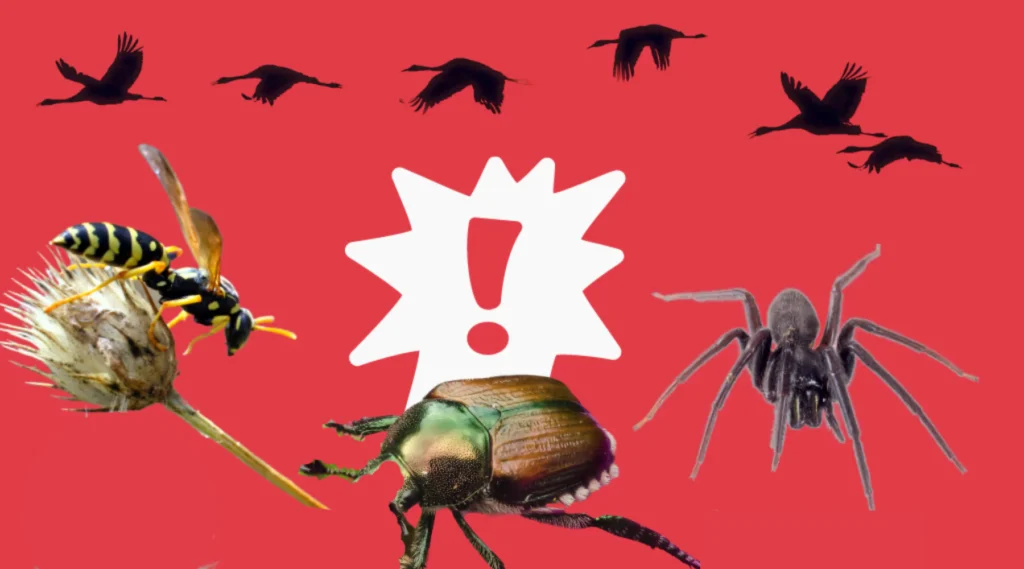
Prevention is key to long-term management and ensuring that Japanese beetles don’t return year after year. By making your lawn and garden less inviting to these pests, you can significantly reduce future infestations and protect your plants.
1. Maintain a Healthy Lawn
A strong, well-maintained lawn is more resistant to grub damage. Healthy grass can withstand minor infestations, preventing widespread die-off.
- Fertilize as needed to promote deep, vigorous root growth, making it harder for grubs to destroy the lawn.
- Aerate the soil annually to improve drainage and nutrient absorption, discouraging grub development.
- Overseed thin areas to create a dense lawn that can resist beetle infestations.
2. Remove Attractants
Japanese beetles are highly attracted to certain plants and food sources. Reducing these can make your yard less inviting.
- Avoid planting highly attractive species like roses, grapevines, linden trees, and raspberries unless you’re prepared for consistent pest management.
- Keep your yard clean by removing:
- Rotting fruit that has fallen from trees or plants.
- Dead leaves and plant debris, which can attract beetles.
- Weeds and overgrowth, as beetles may use these as food sources or breeding grounds.
3. Encourage Natural Predators
Introducing beneficial predators can help control Japanese beetles in your lawn and garden naturally. Many birds and insects see beetles and grubs as a food source.
- Attract birds like starlings and robins by installing bird feeders or birdbaths. These birds eat both adult beetles and grubs.
- Encourage ground beetles and parasitic wasps, which naturally prey on Japanese beetle larvae. You can do this by planting pollinator-friendly flowers and reducing pesticide use.
By following these preventive strategies, you can create a beetle-resistant environment and reduce the chances of another infestation.
With these six steps, you now have a comprehensive plan to identify, control, and prevent Japanese beetles from taking over your lawn and garden!
Managing Japanese beetles in your lawn and garden may seem daunting, but with the right techniques and persistence, it’s absolutely achievable. By focusing on identification, removal, and long-term prevention, you can control Japanese beetles in your lawn and garden without relying on harmful chemicals.
Using a combination of handpicking, natural traps, beneficial nematodes, organic sprays, and preventive measures, you’ll not only protect your plants from damage but also create a healthier, more resilient landscape. Plus, by encouraging natural predators and maintaining a strong, well-kept lawn, you can prevent future infestations before they begin.
The key to success is consistency—taking action early and staying proactive will keep these pests from gaining the upper hand. Start implementing these simple steps today, and reclaim your garden from these persistent invaders for good!
FAQs:
1. What is the most effective way to control Japanese beetles in my lawn and garden?
The most effective approach is a combination of methods. Handpicking adult beetles, applying beneficial nematodes to kill grubs, and using natural deterrents like neem oil or milky spore can significantly reduce their population. Preventive measures, such as maintaining a healthy lawn and removing attractants, will also help keep them from returning.
2. When is the best time to treat for Japanese beetles?
The best time to treat adult Japanese beetles is during their active feeding season, typically from late spring to mid-summer. To control grubs before they mature, apply beneficial nematodes in late summer or early fall and milky spore in spring or fall for long-term prevention.
3. Do Japanese beetle traps really work?
Store-bought Japanese beetle traps can do more harm than good because they attract more beetles than they catch. Instead, try natural traps like planting “trap crops” such as geraniums or marigolds, which lure beetles away from your prized plants without drawing in more from the surrounding area.

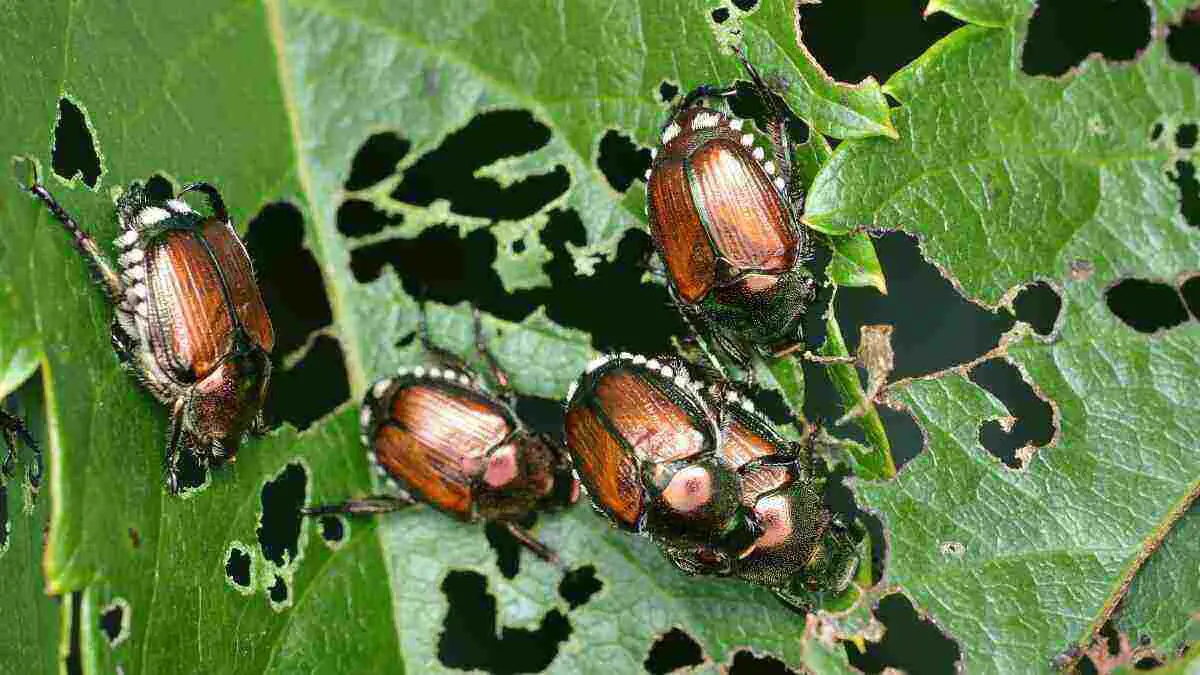
2 thoughts on “How To Control Japanese Beetles in Your Lawn and Garden: No More Damaged Leaves!”